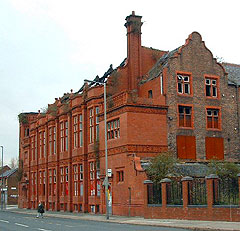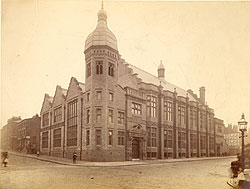
| HOME |
| NERVE |
| REVIEWS |
| ARCHIVE |
| EVENTS |
| LINKS |
| ABOUT US |
| CONTRIBUTORS |
| BACK ISSUES |
| CONTACT US |
 The Florrie:
Saving a Liverpool Icon
The Florrie:
Saving a Liverpool Icon
In the very first issue of Nerve, Mike Fields wrote a great article on the special role played by community centres in Liverpool. He lamented the loss of huge chunks of our social history that have disappeared, gone along with the old buildings that provided the venues and backdrops to our lives. He saw hope in the signs from the grassroots, and was optimistic that their time will come again. This article is about how right he was, and about how arguably the grand-daddy of them all is set to rise again, phoenix from the flames kind of thing. Tom Calderbank (Project Development Officer) walks on with hope in his heart…
The Florence Institute for Boys, known by all as The Florrie, is a Liverpool icon. Nearly everyone ever resident in the immediate area and wider Liverpool could tell you a story about it, good and bad. The good will tell you of the grand and vibrant community centre it once was, a pioneering facility which provided essential youth services, the weekend Dances, the superstars who got their starts there, and the special place it had at the heart of the community for most of the 20th Century. The bad have tales of a derelict eyesore, plagued by vandalism and anti-social behaviour, a blight on the community in recent years, and in need of demolition. Either way, the building is another Liverpool First, an architectural and social gem, and needs urgent attention.
 A
Brief History Lesson
A
Brief History Lesson
The Florrie is a fine building, with a long history of serving the people
of Dingle and South Liverpool. It occupies a unique place in our social
history, as it is arguably the first building ever to be specifically
constructed as a (boy’s) youth club in Great Britain.
In 1889, Sir Bernard Hall, a wealthy merchant and former Lord Mayor of
Liverpool, built the (now Grade 2-listed) Institute in honour of his daughter,
who died in Paris at the untimely age of 22. It was built with the aim
to “provide a place of instruction and recreation for the poor and
working boys of this parish”. Throughout the 20th Century, The Florrie
played an important and positive part in the lives of several generations
of the local community, providing a range of leisure, recreation and educational
services. The comprehensive book on The Florrie has yet to be written,
but would certainly involve thousands of people. Since beginning the campaign,
we have been overwhelmed by the number of people contacting us, passionately
urging us on.
So where did it all go wrong? Depends who you ask. All that matters is
that the building became disused in the 1980’s, and consequently
fell into disrepair in the 1990’s. Subsequent regeneration efforts
became the victims of circumstance and mismanagement, with funders pulling
out of the project, damaging community in-fighting, and a major fire in
1999 which destroyed the roof. Residents were despairing of the problem.
The Florrie continued to defy the best efforts of many people and agencies.
The basic problem was the ownership.
Since the last Trust managing the place dissolved, the title lapsed by
default to the Duchy of Lancaster. This is basically The Queen. I wrote
to her on the issue last summer (got a very nice reply as well, funnily
enough). As Crown property, The Florrie became immune to action. The usual
urgent works notice couldn’t be served. The situation wasn’t
helped by the problem of who was going to take the project forward. The
Florrie was seen as a potential albatross, that could sink any one organisation.
Regeneration schemes came and went, promising so much, delivering so little.
So, just like Waiting for Godot, nothing happened. Even the Capital of
Culture and World Heritage announcements left Florrie unmoved. She just
sat there and rotted.
The Local Authority have maintained basic safety of the building ever
since. Everyone agrees: a permanent solution is needed. Together with
the City Council’s Buildings at Risk team and the Echo’s ‘Stop
The Rot’ campaign, a number of community development agencies in
Liverpool 8, working with tenants and residents, have formed a new Trust,
dedicated to developing plans to address the problem with a creative solution.
If not us, who? If not now, when?
Things are different now. Now, in 2005, with new funding streams available,
a renewed regard for our heritage, and Capital of Culture just over 800
days away, we have an opportunity for one last try at restoration. The
Florence Institute Trust Ltd is a community-led trust, set up at the end
of 2004 to be the key organisation to move the project forward. Working
with a good team (architects Purcell Miller Tritton, for example, continue
to oversee the restoration of St George’s Hall), the new Trust has
gained charitable status and is currently completing the biggest community
consultation on the future of the Florrie ever undertaken. The initial
results are looking good, with an overwhelming amount of community support
for the project. Bids are being finalised for the much needed funding.
Crucially, negotiations with the Duchy of Lancaster’s solicitors
look like having a positive outcome. Pending the necessary insurance and
funding being put in place, the ownership of the building will be transferred
to the new Trust. Once ownership is back in local hands, movement on the
building will be swift. A phased approach, repairing the building and
renewing the roof and services in the first phase, will mean that partial
restoration could be finished in time for 2008.
Regular public meetings have been the driving force behind the campaign.
Many local residents have strenuously pursued the restoration of the Florrie,
for many years. The publicity and momentum generated through the Echo’s
‘Stop The Rot’ campaign has galvanised their efforts. Our
opportunity now lies in this latest (and surely last) effort to save the
building, and the optimistic new efforts to regenerate Liverpool as a
whole. And compared to a lot of major capital projects in the city at
the moment, the current price tag of £4.5 million seems cheap as
chips.
Meeting the needs of the 21st Century
This is it, now folks. It’s been a long time coming, but the time is NOW. This is a community-led initiative, one of the largest in New Liverpool, and as such, will pose challenges for us all in the time to come, so we need to be together and ready. A lot has been talked over the years about saving The Florrie, but just look at it today. It tells its own story. Future generations wouldn’t thank us for our stewardship. At this stage of the game, roughly the 89th minute as far as the building – and the community’s patience - is concerned, talk is cheap. The people of the area rightly demand deeds not words. So our challenge for you is to help us make it happen. To restore the building to its rightful place in our lives.
The New Florrie will help improve local pride, self-esteem and quality
of life. It will enhance and improve all other local strategic efforts
in the realms of employment, education, regeneration, anti-poverty, childcare,
youth work, training, neighbourhood services, health, elder provision,
community safety/cohesion, and more. Importantly, it would still be here
in 2009, and after.
My challenge now is for everyone who cares about Liverpool, to come together
in a spirit of co-operation, with a ‘can-do’ attitude, and
help make this priceless project happen. If you would like further information
on The Florrie Restoration Campaign, contact the Project Management Team
(details below), and remember:
It’s NOT too late – SAVE THE FLORRIE FOR 2008!
Contact:
The Florence Institute Trust Ltd,
c/o Toxteth Town Hall Community Resource Centre,
15 High Park Street,
Liverpool, L8 8DX
Mobile: 0790 4567 726
Website: www.savetheflorrie.org.uk